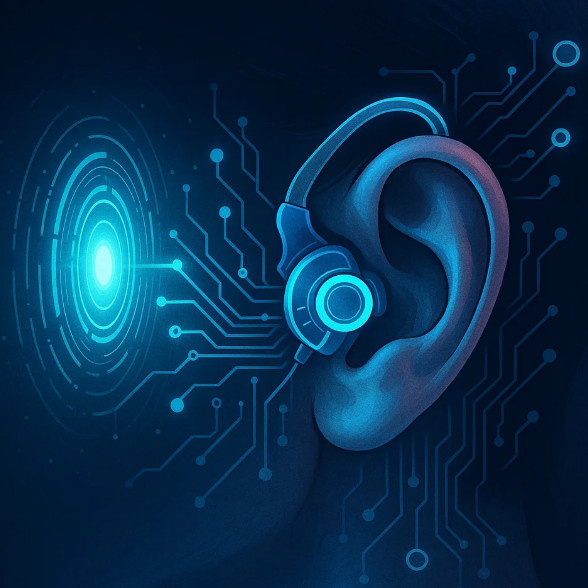к·Җм—җм„ң м—ҙлҰ¬лҠ” лҜёлһҳ
- Earable Technology, мқёк°„кіј кё°мҲ мқҳ мғҲлЎңмҡҙ мқён„°нҺҳмқҙмҠӨ
мҡ°лҰ¬лҠ” л“ЈлҠ” мЎҙмһ¬лӢӨ. к·ёлҹ¬лӮҳ мқҙм ң, л“ЈлҠ”лӢӨлҠ” н–үмң„к°Җ мқёк°„мқҳ к°җк°Ғмқ„ л„ҳм–ҙ кё°мҲ мқҳ м–ём–ҙк°Җ лҗҳкі мһҲлӢӨ. к·ҖлҠ” лҚ” мқҙмғҒ лӢЁмҲңн•ң мІӯк°Ғ кё°кҙҖмқҙ м•„лӢҲлқј, мқёк°„мқҳ мӢ нҳёлҘј н•ҙм„қн•ҳкі кё°мҲ кіј лҢҖнҷ”н•ҳлҠ” мғҲлЎңмҡҙ мқён„°нҺҳмқҙмҠӨлЎң 진нҷ”н•ҳкі мһҲлӢӨ.
к°җк°Ғмқҳ кІҪкі„к°Җ л¬ҙл„Ҳ진лӢӨ: к·Җ, мғҲлЎңмҡҙ нҳҒмӢ мқҳ нҳ„мһҘ
мқёк°„мқҳ мӢ мІҙлҠ” м–ём ңлӮҳ кё°мҲ мқҳ мөңм „м„ мқҙм—ҲлӢӨ. мҶҗлҒқмқҳ мҠӨл§ҲнҠёнҸ°, мҶҗлӘ©мқҳ мӣҢм№ҳ, к·ёлҰ¬кі мқҙм ңлҠ” к·ҖлӢӨ. мқёкіөм§ҖлҠҘ, мғқмІҙ м„јм„ң, мӮ¬мҡҙл“ң мқён„°нҺҳмқҙмҠӨк°Җ мңөн•©лҗҳл©° вҖҳк·ҖвҖҷлҠ” лӢЁмҲңнһҲ л“ЈлҠ” кё°кҙҖмқ„ л„ҳм–ҙ мқёк°„кіј кё°кі„мқҳ кІҪкі„л©ҙмңјлЎң 진нҷ”н•ҳкі мһҲлӢӨ.
2025л…„мқҳ мқҙм–ҙлҹ¬лё” кё°мҲ мқҖ лӢЁмҲңн•ң мҳӨл””мҳӨ кё°кё°к°Җ м•„лӢҲлӢӨ. 'A Survey of Earable Technology: Trends, Tools, and the Road Ahead'лҠ” мқҙм–ҙлҹ¬лё”мқ„ мқёк°„мқҳ к°җк°Ғкіј лҚ°мқҙн„°лҘј мһҮлҠ” вҖҳмӢ кІҪл§қ мқён„°нҺҳмқҙмҠӨ(neural interface)вҖҷлЎң м •мқҳн•ңлӢӨ.
мөңк·ј мқҙм–ҙнҸ° мӢңмһҘмқҖ лӢЁмҲңн•ң мқҢн–Ҙ кё°кё°лҘј л„ҳм–ҙ мқёк°„мқҳ к°җк°Ғ мӢңмҠӨн…ң м „мІҙлҘј л””м§Җн„ёнҷ”н•ҳлҠ” мӢӨн—ҳмқҳ мһҘмқҙ лҗҳкі мһҲлӢӨ. мҶҢлӢҲлҠ” вҖҳLinkBudsвҖҷ мӢңлҰ¬мҰҲлҘј нҶөн•ҙ к·ҖлҘј м—ҙм–ҙл‘җкі мЈјліҖ мҶҢлҰ¬лҘј н•Ёк»ҳ мқёмӢқн•ҳлҠ” вҖҳмҳӨн”Ҳ-мқҙм–ҙ(open-ear)вҖҷ к°ңл…җмқ„ нҷ•мӮ°мӢңмј°кі , м• н”ҢмқҖ м°Ём„ёлҢҖ AirPodsм—җ мІҙмҳЁВ·мӢ¬л°• мёЎм • кё°лҠҘмқ„ нғ‘мһ¬н•ҳкё° мң„н•ҙ нҠ№н—ҲлҘј л“ұлЎқн–ҲлӢӨ. кө¬кёҖ м—ӯмӢң вҖҳProject EuphoniaвҖҷлҘј нҶөн•ҙ мІӯк°Ғ лҚ°мқҙн„°лҘј нҷңмҡ©н•ң мқҢм„ұ мқёмӢқ кё°мҲ мқҳ м •л°ҖлҸ„лҘј лҶ’мқҙкі мһҲлӢӨ. мқҙмІҳлҹј к·ҖлҠ” мқҙм ң мқҢм•…мқ„ л“ЈлҠ” лҸ„кө¬к°Җ м•„лӢҲлқј, мқёк°„мқҳ мғҒнғңлҘј мӢӨмӢңк°„мңјлЎң к°җм§Җн•ҳкі н”јл“ңл°ұн•ҳлҠ” к°җк°Ғ н—ҲлёҢлЎң 진нҷ”н•ҳкі мһҲлӢӨ.
мІӯк°Ғмқ„ л„ҳм–ҙ мӢ мІҙлЎң: мқҙм–ҙлҹ¬лё”мқҳ нҷ•мһҘлҗң к°җк°Ғ
к·ҖлҠ” мІӯк°Ғ кё°кҙҖмқҙм§Җл§Ң, лҸҷмӢңм—җ мғқмІҙ мӢ нҳёмқҳ ліҙкі (еҜ¶еә«)лӢӨ. лЁёлҰ¬мҷҖ лҮҢм—җ к°ҖмһҘ к°Җк№Ңмҡҙ мң„м№ҳм—җ мһҲм–ҙ, мІҙмҳЁВ·нҳҲлҘҳВ·лҮҢнҢҢ л“ұмқҳ ліҖнҷ”лҘј м •л°Җн•ҳкІҢ мёЎм •н• мҲҳ мһҲлӢӨ. мқҙм–ҙлҹ¬лё”мқҖ л°”лЎң мқҙ м җмқ„ нҷңмҡ©н•ңлӢӨ. мөңк·ј м—°кө¬м—җм„ңлҠ” к·Җ м•ҲмӘҪ н”јл¶Җмқҳ лҜём„ён•ң м „кё° м „лҸ„лҸ„ ліҖнҷ”лҘј нҶөн•ҙ мҠӨнҠёл ҲмҠӨ мҲҳмӨҖмқ„ мҳҲмёЎн•ҳкұ°лӮҳ, к·Җ мЈјліҖ нҳҲлҘҳмқҳ м Ғмҷём„ л°ҳмӮ¬лҘј 분м„қн•ҙ нҳҲмӨ‘ мӮ°мҶҢ нҸ¬нҷ”лҸ„лҘј мёЎм •н•ҳлҠ” кё°мҲ мқҙ л“ұмһҘн–ҲлӢӨ.
MIT лҜёл””м–ҙлһ©мқҖ вҖҳEar-EEGвҖҷлқјлҠ” мӢңмҠӨн…ңмқ„ к°ңл°ңн•ҙ, к·Җ м•ҲмӘҪм—җ мҙҲмҶҢнҳ• м „к·№мқ„ л°°м№ҳн•ҙ лҮҢнҢҢлҘј мӢӨмӢңк°„мңјлЎң лӘЁлӢҲн„°л§Ғн•ҳкі мҲҳл©ҙмқҳ м§Ҳмқ„ 분м„қн•ңлӢӨ. мқҙ кё°мҲ мқҖ кё°мЎҙмқҳ л‘җк°ң(й ӯи“Ӣ)нҳ• EEGліҙлӢӨ нӣЁм”¬ нҺём•Ҳн•ҳкі , мқјмғҒмғқнҷң мҶҚм—җм„ңлҸ„ м°©мҡ© к°ҖлҠҘн•ҳлӢӨлҠ” мһҘм җмқҙ мһҲлӢӨ. мқҙлҹ¬н•ң лҚ°мқҙн„°лҠ” мқёкіөм§ҖлҠҘ м•Ңкі лҰ¬мҰҳкіј кІ°н•©лҗҳм–ҙ мӮ¬мҡ©мһҗмқҳ н”јлЎң, 집мӨ‘лҸ„, к°җм • мғҒнғңлҘј мҳҲмёЎн•ҳлҠ” лҚ° нҷңмҡ©лҗңлӢӨ.
мғҒмҡ©нҷ”м—җм„ңлҸ„ мӣҖм§Ғмһ„мқҙ нҷңл°ңн•ҳлӢӨ. ліҙмҠӨ(Bose)лҠ” вҖҳSoundControl Hearing AidвҖҷлҘј нҶөн•ҙ мӮ¬мҡ©мһҗмқҳ мІӯк°Ғ нҠ№м„ұм—җ л”°лқј мһҗлҸҷмңјлЎң мқҢм—ӯлҢҖлҘј ліҙм •н•ҳлҠ” кё°мҲ мқ„ м„ ліҙмҳҖкі , мӮјм„ұм „мһҗлҠ” к°ӨлҹӯмӢң лІ„мҰҲ мӢңлҰ¬мҰҲм—җ мқҢм•• кё°л°ҳмқҳ к·Җ лӮҙл¶Җ м Ғмқ‘нҳ• мӮ¬мҡҙл“ң кё°лҠҘмқ„ нғ‘мһ¬н•ҙ мІӯл Ҙ ліҙнҳё кё°лҠҘмқ„ к°•нҷ”н–ҲлӢӨ. мқҙлҹ¬н•ң ліҖнҷ”лҠ” лӢЁмҲңнһҲ вҖҳлҚ” мўӢмқҖ мҶҢлҰ¬вҖҷлҘј мң„н•ң кІғмқҙ м•„лӢҲлқј, мІӯк°Ғмқ„ л§Өк°ңлЎң мқёк°„мқҳ мғқлҰ¬мҷҖ м •м„ңлҘј лҸҷмӢңм—җ кҙҖлҰ¬н•ҳлҠ” кё°мҲ лЎң нҷ•мһҘлҗҳкі мһҲлӢӨ.
к·ҖлЎң мқҪлҠ” лҚ°мқҙн„°: AIк°Җ к°җм •мқ„ л“ЈлӢӨ
AIмҷҖ кІ°н•©н•ң мқҙм–ҙлҹ¬лё”мқҖ мқҙм ң мӮ¬мҡ©мһҗмқҳ вҖҳк°җм •вҖҷмқ„ л“Јкё° мӢңмһ‘н–ҲлӢӨ. мқҙлҠ” мІӯк°Ғ лҚ°мқҙн„°мҷҖ мғқмІҙ лҚ°мқҙн„°лҘј нҶөн•© 분м„қн•ЁмңјлЎңмҚЁ к°ҖлҠҘн•ң мқјмқҙлӢӨ. 2025л…„ м№ҙмқҙмҠӨнҠё м—°кө¬м§„мқҖ мқҙм–ҙнҸ° лӮҙл¶Җм—җ лӮҙмһҘлҗң MEMS(мҙҲмҶҢнҳ• л§ҲмқҙнҒ¬лЎңм „мһҗ мӢңмҠӨн…ң) м„јм„ңлҘј мқҙмҡ©н•ҙ, мқҢм„ұмқҳ лҜём„ён•ң л–ЁлҰјкіј нҳҲлҘҳ ліҖнҷ”лҘј лҸҷмӢң 분м„қн•ҳм—¬ мӮ¬мҡ©мһҗмқҳ мҠӨнҠёл ҲмҠӨ м§ҖмҲҳлҘј 95% мқҙмғҒ м •нҷ•лҸ„лЎң мёЎм •н•ҳлҠ” м•Ңкі лҰ¬мҰҳмқ„ к°ңл°ңн–ҲлӢӨ.
мқҙ кё°мҲ мқҖ мқҙлҜё лӢӨм–‘н•ң мӮ°м—…м—җ нҷ•мӮ°лҗҳкі мһҲлӢӨ. мҳҲлҘј л“Өм–ҙ кёҖлЎңлІҢ мқҢн–Ҙ кё°м—… м н•ҳмқҙм Җ(Sennheiser)лҠ” мӮ¬мҡ©мһҗ к°җм •м—җ л”°лқј мқҢм•…мқҳ н…ңнҸ¬лҘј мһҗлҸҷ мЎ°м •н•ҳлҠ” вҖҳAdaptive Mood SoundвҖҷлҘј мӢӨн—ҳ мӨ‘мқҙлӢӨ. 집мӨ‘лҸ„к°Җ л–Ём–ҙм§Җл©ҙ лҰ¬л“¬мқҙ лӢЁмЎ°лЎңмӣҢм§Җкі , мҠӨнҠёл ҲмҠӨк°Җ лҶ’м•„м§Җл©ҙ 차분н•ң мқҢм—ӯмңјлЎң м „нҷҳлҗңлӢӨ. кё°мҲ мқҙ лӢЁмҲңнһҲ к·ҖлҘј нҶөн•ҙ м •ліҙлҘј вҖҳліҙлӮҙлҠ”вҖҷ мҲҳмӨҖмқ„ л„ҳм–ҙ, мқёк°„мқҳ лӮҙл©ҙ мғҒнғңлҘј вҖҳк°җм§Җн•ҳкі л°ҳмқ‘н•ҳлҠ”вҖҷ лӢЁкі„лЎң 진мһ…н•ң кІғмқҙлӢӨ.
н•ңнҺё, л©”нғҖ(Meta)лҠ” мһҗмӮ¬мқҳ вҖҳReality LabsвҖҷлҘј нҶөн•ҙ мІӯк°Ғ мӨ‘мӢ¬мқҳ нҷ•мһҘнҳ„мӢӨ(AR) мӢңмҠӨн…ңмқ„ м—°кө¬н•ҳкі мһҲлӢӨ. мқҙ мӢңмҠӨн…ңмқҖ мӮ¬мҡ©мһҗмқҳ мң„м№ҳ, к°җм •, мЈјліҖ мҶҢмқҢ л“ұмқ„ лҸҷмӢңм—җ 분м„қн•ҙ нҳ„мӢӨ м„ёкі„мқҳ мҶҢлҰ¬лҘј л””м§Җн„ё м •ліҙмҷҖ кІ°н•©мӢңнӮЁлӢӨ. мҳҲм»ЁлҢҖ нҡҢмқҳ мӨ‘ н”јлЎңлҸ„к°Җ лҶ’мңјл©ҙ лӘ©мҶҢлҰ¬лҘј мһҗлҸҷмңјлЎң лҳҗл ·н•ҳкІҢ к°•мЎ°н•ҳкұ°лӮҳ, нҠ№м • мқёл¬јмқҳ л°ңм–ёмқ„ мҡ°м„ м ҒмңјлЎң мқёмӢқн•ҙ мІӯк°Ғ н”јлЎңлҘј мӨ„мқҙлҠ” л°©мӢқмқҙлӢӨ. AIк°Җ к·ҖлҘј нҶөн•ҙ мқёк°„мқҳ м •мӢ мғҒнғңмҷҖ мЈјмқҳ 집мӨ‘мқ„ лҸҷм ҒмңјлЎң мЎ°мңЁн•ҳлҠ” мӢңлҢҖк°Җ лҸ„лһҳн•ң кІғмқҙлӢӨ.
м№ҳмң н•ҳлҠ” к·Җ: н—¬мҠӨмјҖм–ҙ н”Ңлһ«нҸјмңјлЎңмқҳ 진нҷ”
к·ҖлҠ” мқҙм ң кұҙк°• кҙҖлҰ¬мқҳ н”Ңлһ«нҸјмңјлЎң мһҗлҰ¬ мһЎкі мһҲлӢӨ. мқҙм–ҙлҹ¬лё”мқ„ нҶөн•ҙ мёЎм •н•ң лҚ°мқҙн„°лҠ” лӢЁмҲңнһҲ кё°лЎқмқ„ л„ҳм–ҙ вҖҳмҳҲмёЎвҖҷмңјлЎң 진нҷ”н•ҳкі мһҲлӢӨ. AI кё°л°ҳ мқҙм–ҙлҹ¬лё”мқҖ мӮ¬мҡ©мһҗмқҳ лҮҢнҢҢ нҢЁн„ҙкіј мӢ¬л°• ліҖнҷ”лҘј 분м„қн•ҙ мҡ°мҡёк°җмқҙлӮҳ л¶Ҳм•Ҳ мғҒнғңлҘј мЎ°кё° к°җм§Җн•ҳкі , мқҢм•…мқҙлӮҳ мқҢм„ұ н”јл“ңл°ұмңјлЎң мһҗмңЁмӢ кІҪкі„лҘј м•Ҳм •мӢңнӮӨлҠ” мӨ‘мһ¬лҘј мӢңлҸ„н•ңлӢӨ.
мҳҒкөӯмқҳ мҠӨнғҖнҠём—… л…ёмқҙмҰҲн”ҢлқјмӣҢ(NoiseFlower)лҠ” мӮ¬мҡ©мһҗмқҳ мІӯк°Ғ н”јлЎңлҸ„лҘј 분м„қн•ҙ, мқјм • мҲҳмӨҖ мқҙмғҒмқҙ лҗҳл©ҙ мһҗлҸҷмңјлЎң мҶҢлҰ¬лҘј мӨ„мқҙкұ°лӮҳ нҠ№м • мЈјнҢҢмҲҳлҘј м°ЁлӢЁн•ҳлҠ” AI мІӯм·Ё кҙҖлҰ¬ кё°лҠҘмқ„ м„ ліҙмҳҖлӢӨ. лҳҗ мқјліёмқҳ мҶҢлӢҲлҠ” мқёкіөлӢ¬нҢҪмқҙкҙҖ(artificial cochlea) н”„лЎңм қнҠёлҘј нҶөн•ҙ мІӯк°Ғ мһҘм• мқёмқҳ мӢ кІҪ нҢЁн„ҙмқ„ н•ҙм„қн•ҙ м „мһҗ мӢ нҳёлЎң ліҖнҷҳн•ҳлҠ” мӢңмҠӨн…ңмқ„ к°ңл°ң мӨ‘мқҙлӢӨ. мқҙ кё°мҲ мқҖ лӢЁмҲңнһҲ мІӯк°Ғмқ„ ліөмӣҗн•ҳлҠ” кІғмқҙ м•„лӢҲлқј, вҖҳк°җк°Ғмқҳ лІҲм—ӯвҖҷмқҙлқјлҠ” мғҲлЎңмҡҙ к°ңл…җмқ„ мӢӨнҳ„н•ңлӢӨ.
мҡҙлҸҷВ·мқҳлЈҢ 분야м—җм„ңлҸ„ мқҙм–ҙлҹ¬лё”мқҳ м—ӯн• мқҙ м»Өм§Җкі мһҲлӢӨ. мҳҲлҘј л“Өм–ҙ лҜёкөӯмқҳ мҠӨнғҖнҠём—… м•ҢлҰ¬лёҢ(AliveCor)лҠ” к·ҖлҘј нҶөн•ң мӢ¬м „лҸ„(ECG) мёЎм • кё°лҠҘмқ„ м—°кө¬ мӨ‘мқҙл©°, мқҙ лҚ°мқҙн„°лҠ” л¶Ҳк·ңм№ҷн•ң мӢ¬л°•мқҙлӮҳ л¶Җм •л§Ҙмқ„ мЎ°кё° нғҗм§Җн•ҳлҠ” лҚ° нҷңмҡ©лҗңлӢӨ. мқҙлҠ” мӣЁм–ҙлҹ¬лё”мқҙ кұҙк°• лӘЁлӢҲн„°л§Ғмқҳ ліҙмЎ° мһҘм№ҳлҘј л„ҳм–ҙ, вҖҳмҳҲл°© мқҳн•ҷмқҳ м „мҙҲкё°м§ҖвҖҷк°Җ лҗҳм–ҙк°Җкі мһҲмқҢмқ„ мқҳлҜён•ңлӢӨ.
кё°мҲ мқҙ л“Јкі , мқёк°„мқҙ л§җн•ңлӢӨ: HMIмқҳ мһ¬м •мқҳ
мқёк°„мқҖ мҳӨлһ«лҸҷм•Ҳ мҶҗмңјлЎң кё°мҲ мқ„ лӢӨлӨ„мҷ”лӢӨ. н•ҳм§Җл§Ң мқҙм–ҙлҹ¬лё”мқҳ л“ұмһҘмңјлЎң мқёк°„-кё°кі„ мқён„°нҺҳмқҙмҠӨ(HMI, Human-Machine Interface)мқҳ мӨ‘мӢ¬мқҖ мҶҗм—җм„ң к°җк°ҒмңјлЎң мҳ®кІЁк°Җкі мһҲлӢӨ. мӮ¬мҡ©мһҗлҠ” лҚ” мқҙмғҒ нҷ”л©ҙмқ„ н„°м№ҳн•ҳм§Җ м•Ҡм•„лҸ„ лҗңлӢӨ. кё°мҲ мқҖ к·ҖлҘј нҶөн•ҙ мқёк°„мқҳ мғҒнғңлҘј мқҪкі , мӮ¬мҡ©мһҗмқҳ н•„мҡ”м—җ л§һкІҢ л°ҳмқ‘н•ңлӢӨ.
лүҙлҹҙл§ҒнҒ¬(Neuralink)лҠ” мІӯк°Ғ мӢ кІҪм—җ м§Ғм ‘ мӢ нҳёлҘј м „лӢ¬н•ҳлҠ” мӢӨн—ҳмқ„ нҶөн•ҙ, к·ҖмҷҖ лҮҢлҘј мһҮлҠ” мӢ кІҪ мқён„°нҺҳмқҙмҠӨмқҳ к°ҖлҠҘм„ұмқ„ нғҗкө¬н•ҳкі мһҲлӢӨ. м•„м§ҒмқҖ мқҳлЈҢмҡ©мңјлЎң н•ңм •лҗҳм–ҙ мһҲм§Җл§Ң, н–Ҙнӣ„ к°җк°Ғ мҰқк°•(sensory augmentation) 분야лЎң нҷ•мһҘлҗ м—¬м§Җк°Җ нҒ¬лӢӨ. мқҙлҹ¬н•ң кё°мҲ мқҖ лӢЁмҲңн•ң ліҙмЎ°мһҘм№ҳлҘј л„ҳм–ҙ, мқёк°„мқҳ к°җк°Ғкіј кё°мҲ мқҙ мӢӨмӢңк°„мңјлЎң вҖҳлҢҖнҷ”н•ҳлҠ” мЎҙмһ¬вҖҷлЎң 진нҷ”н•ҳлҠ” мІ«кұёмқҢмқҙлӢӨ.
мҳҲлҘј л“Өм–ҙ лҜёлһҳмқҳ мқҙм–ҙлҹ¬лё”мқҖ мӮ¬мҡ©мһҗк°Җ н”јкіӨн• л•Ң вҖң집мӨ‘ лӘЁл“ңвҖқлЎң м „нҷҳн•ҳкі , мҷёл¶Җмқҳ мҶҢмқҢмқ„ мӨ„мқҙкұ°лӮҳ, мқҢм„ұ 비м„ңлҘј нҶөн•ҙ мӢ¬нҳёнқЎмқ„ мң лҸ„н• мҲҳлҸ„ мһҲлӢӨ. мҰү, кё°мҲ мқҙ мқёк°„мқҳ мғқмІҙ лҰ¬л“¬мқ„ к°җм§Җн•ҳкі , мқёк°„мқҖ м–ём–ҙ м—ҶмқҙлҸ„ кё°мҲ кіј к°җк°Ғм ҒмңјлЎң мҶҢнҶөн•ҳлҠ” мӢңлҢҖлӢӨ.
лҚ°мқҙн„°мқҳ к·Җнҷҳ: н”„лқјмқҙлІ„мӢңмҷҖ мӢ лў°мқҳ кё°мҲ
к·ҖлҠ” к°ңмқёмқҳ мғқмІҙ м •ліҙк°Җ к°ҖмһҘ л§Һмқҙ 집м•ҪлҗҳлҠ” кё°кҙҖмқҙлӢӨ. мІҙмҳЁ, мӢ¬л°•, лҮҢнҢҢ, к°җм • мғҒнғң—all in one. мқҙлҹ° лҚ°мқҙн„°лҠ” лҜјк°җн•ҳл©ҙм„ңлҸ„ к°•л Ҙн•ҳлӢӨ. н•ҳм§Җл§Ң лҸҷмӢңм—җ, к°ңмқём •ліҙ мң м¶ңмқҙлӮҳ к°җм • мЎ°мһ‘мқҳ мң„н—ҳмқҙ мЎҙмһ¬н•ңлӢӨ.
2025л…„ мң лҹҪм—°н•©(EU)мқҖ вҖҳHuman Sensory Data ActвҖҷлҘј л°ңн‘ңн•ҙ мқҙм–ҙлҹ¬лё” кё°кё°лҘј нҶөн•ң мғқмІҙ мӢ нҳё мҲҳ집 л°Ҹ нҷңмҡ©м—җ лҢҖн•ң лІ•м Ғ к°Җмқҙл“ңлқјмқёмқ„ лӘ…нҷ•нһҲ н–ҲлӢӨ. лҚ°мқҙн„°лҠ” мӮ¬мҡ©мһҗмқҳ лҸҷмқҳ м—Ҷмқҙ м ң3мһҗм—җкІҢ кіөмң лҗ мҲҳ м—Ҷмңјл©°, к°җм • лҚ°мқҙн„°лҠ” мғҒм—…м Ғ кҙ‘кі м—җ нҷңмҡ©лҗ мҲҳ м—ҶлҸ„лЎқ м ңн•ңлҗҳм—ҲлӢӨ. кё°мҲ мқҙ мқёк°„мқҳ мӢ мІҙлҘј мқҪлҠ” л§ҢнҒј, вҖҳмӢ лў°вҖҷлҠ” кё°мҲ л°ңм „мқҳ н•өмӢ¬ мһҗмӮ°мқҙ лҗҳм—ҲлӢӨ.
мқҙм—җ л”°лқј кё°м—…л“ӨмқҖ вҖҳн”„лқјмқҙлІ„мӢң мӨ‘мӢ¬ л””мһҗмқё(Privacy by Design)вҖҷмқ„ н‘ңмӨҖнҷ”н•ҳкі мһҲлӢӨ. кө¬кёҖмқҖ мқҙм–ҙнҸ°мқҳ к°җм • мқёмӢқ кё°лҠҘмқ„ нҒҙлқјмҡ°л“ң лҢҖмӢ лЎң컬 칩м—җм„ң мІҳлҰ¬н•ҳлҸ„лЎқ м„Өкі„н–Ҳмңјл©°, м• н”ҢмқҖ кұҙк°• лҚ°мқҙн„°мқҳ м•”нҳёнҷ”лҘј к°•нҷ”н•ҙ кё°кё° лӮҙл¶Җм—җм„ңл§Ң мІҳлҰ¬н•ҳлҸ„лЎқ н–ҲлӢӨ. кё°мҲ мқҙ мқёк°„мқҳ к°җк°Ғмқ„ нҷ•мһҘн• мҲҳлЎқ, мӢ лў°мқҳ кё°мҲ мқҙ н•Ёк»ҳ 진нҷ”н•ҙм•ј н•ҳлҠ” мқҙмң лӢӨ.
к·ҖлЎң мқҙм–ҙ진 кіөк°җмқҳ л„ӨнҠёмӣҢнҒ¬
мқҙ лӘЁл“ кё°мҲ мқҖ кІ°көӯ мқёк°„мқҳ мҶҢнҶөмңјлЎң к·ҖкІ°лҗңлӢӨ. мқҙм–ҙлҹ¬лё”мқҖ к°ңмқёмқҳ лҚ°мқҙн„°лҘј мқҪлҠ” кё°кі„мқҙкё°лҸ„ н•ҳм§Җл§Ң, лҸҷмӢңм—җ нғҖмқёкіјмқҳ м—°кІ°мқ„ лҸ•лҠ” мӮ¬нҡҢм Ғ л§Өк°ңмІҙлӢӨ. мқҢм•…, нҶөнҷ”, нҡҢмқҳ, нҳ‘м—…—лӘЁл“ мқёк°„м Ғ мғҒнҳёмһ‘мҡ©мқҳ м Ҳл°ҳ мқҙмғҒмқҙ мІӯк°Ғмқ„ л§Өк°ңлЎң мқҙлӨ„진лӢӨ.
л”°лқјм„ң мқҙм–ҙлҹ¬лё”мқҖ лӢЁмҲңнһҲ нҡЁмңЁмқ„ лҶ’мқҙлҠ” лҸ„кө¬к°Җ м•„лӢҲлқј, мқёк°„ кҙҖкі„мқҳ мғҲлЎңмҡҙ мқён„°нҺҳмқҙмҠӨлӢӨ. мҳҲм»ЁлҢҖ мҠӨнғҖнҠём—… лҰ¬лӢҲм–ҙ(Linear)лҠ” мӢӨмӢңк°„ лІҲм—ӯ мқҙм–ҙлІ„л“ңлҘј нҶөн•ҙ м–ём–ҙ мһҘлІҪмқ„ н—Ҳл¬јм—Ҳкі , вҖҳHushWearвҖҷлҠ” мӣҗкІ© к·јл¬ҙмһҗл“Өмқҙ нҢҖмӣҗмқҳ лӘ©мҶҢлҰ¬ нҶӨкіј к°җм • мғҒнғңлҘј мӢӨмӢңк°„мңјлЎң к°җм§Җн•ҙ кіөк°җ н”јл“ңл°ұмқ„ мЈјлҠ” мӢңмҠӨн…ңмқ„ к°ңл°ңн–ҲлӢӨ.
кё°мҲ мқҙ мқёк°„мқҳ лӮҙл©ҙмқ„ мқҪмқ„ мҲҳ мһҲм§Җл§Ң, к·ёкІғмқҙ вҖҳмқҙн•ҙвҖҷмҷҖ вҖҳкіөк°җвҖҷмңјлЎң м—°кІ°лҗ л•Ң м§„м •н•ң нҳҒмӢ мқҙ лҗңлӢӨ. к·ҖлЎң м—°кІ°лҗң м„ёмғҒмқҖ лҚ” к°ңмқём Ғмқё лҸҷмӢңм—җ лҚ” кіөлҸҷмІҙм ҒмқҙлӢӨ. мқҙм–ҙлҹ¬лё”мқҖ лӢЁмҲңн•ң мІӯк°Ғмқҳ лҸ„кө¬к°Җ м•„лӢҲлқј, к°җм •мқҳ м–ём–ҙлҘј лӢӨмӢң м“°лҠ” мӮ¬нҡҢм Ғ кё°мҲ мқҙлӢӨ.
кё°мҲ мқҙ л“ЈлҠ” м„ёмғҒ, мқёк°„мқҙ л§җн•ҳлҠ” лҜёлһҳ
лӢӨк°Җмҳ¬ мӢңлҢҖмқҳ мқҙм–ҙлҹ¬лё”мқҖ лҚ” мқҙмғҒ кё°кё°к°Җ м•„лӢҲлӢӨ. к·ёкІғмқҖ мқёк°„мқҳ к°җк°Ғ кө¬мЎ°м—җ нҶөн•©лҗң вҖҳкіөмЎҙм Ғ м§ҖлҠҘ(coexisting intelligence)вҖҷмқҙлӢӨ.
кё°мҲ мқҖ мҡ°лҰ¬мқҳ мІӯк°Ғмқ„ ліҙмҷ„н•ҳлҠ” лҸҷмӢңм—җ, мқёк°„мқҳ к°җм •мқ„ мқҙн•ҙн•ҳкі лҢҖнҷ”н•ҳлҠ” мЎҙмһ¬лЎң 진нҷ”н•ҳкі мһҲлӢӨ. к·ҖлҠ” лҚ” мқҙмғҒ л“Јкё°л§Ң н•ҳлҠ” кё°кҙҖмқҙ м•„лӢҲлӢӨ.
к·ёкІғмқҖ м„ёмғҒкіј лӮҳ, к·ёлҰ¬кі кё°мҲ мқҙ л§ҢлӮҳлҠ” кІҪкі„лӢӨ. мқёк°„мқҙ л“ЈлҠ” кё°мҲ м—җм„ң, кё°мҲ мқҙ мқёк°„мқ„ мқҙн•ҙн•ҳлҠ” кё°мҲ лЎң — мҡ°лҰ¬лҠ” м§ҖкёҲ к·ё м „нҷҳм җ мң„м—җ м„ң мһҲлӢӨ.
Reference
Hu, Changshuo et al. (2025). 'A Survey of Earable Technology: Trends, Tools, and the Road Ahead.' arXiv preprint, June 2025.
The Future Opens Through the Ear
- Earable Technology: A New Interface Between Humans and Machines
We are beings who listen. Yet listening is no longer merely a human act—it is becoming the language of technology itself. The ear is no longer just an organ of hearing; it is evolving into an intelligent interface that decodes human signals and communicates with machines.
Breaking the Boundaries of the Senses: The Ear as a New Frontier of Innovation
The human body has always been the frontier of technology. From smartphones at our fingertips to watches on our wrists—and now to our ears. With the convergence of artificial intelligence, biosensors, and sound interfaces, the ear is transforming from a passive organ of perception into a dynamic boundary where humans and machines meet.
In 2025, earable technology is no longer a simple audio device. 'A Survey of Earable Technology: Trends, Tools, and the Road Ahead' defines earables as вҖңneural interfacesвҖқ that connect human senses with digital data, marking a new era of AI-driven hardware fusion.
TodayвҖҷs earphone market is not about sound quality alone—it is a testing ground for digitizing the entire human sensory system. SonyвҖҷs вҖңLinkBudsвҖқ series introduced the concept of open-ear design that keeps the ears physically open to ambient sounds, while Apple has filed patents for adding body temperature and heart-rate sensors to the next generation of AirPods. GoogleвҖҷs вҖңProject EuphoniaвҖқ is refining speech recognition accuracy using individualized hearing data. The ear, once merely a channel for music, is becoming a real-time hub that senses and responds to the human body itself.
Beyond Hearing: The Expanding Sensory Realm of Earables
The ear is not only a hearing organ but also a reservoir of physiological signals. Positioned closest to the brain, it provides an ideal site for measuring variables such as temperature, blood flow, and brain waves. Earables capitalize on this unique anatomical advantage. Recent studies have shown that minute changes in the ear canalвҖҷs electrical conductivity can reveal stress levels, and infrared reflection from blood flow can measure oxygen saturation.
MITвҖҷs Media Lab has developed an вҖңEar-EEGвҖқ system that places micro-electrodes inside the ear canal to monitor brain waves and analyze sleep quality in real time. Unlike conventional head-mounted EEG devices, this system is comfortable, discreet, and wearable throughout daily life. The collected data are then processed by AI algorithms to predict levels of fatigue, focus, and emotional stability.
Commercial applications are quickly following. BoseвҖҷs вҖңSoundControl Hearing AidвҖқ automatically adjusts frequencies based on the userвҖҷs unique hearing profile. SamsungвҖҷs Galaxy Buds series now features adaptive in-ear sound pressure control to protect hearing in noisy environments. These advances are not simply about better acoustics—they represent the fusion of auditory perception, physiology, and emotional well-being.
Reading Data Through the Ear: AI Begins to Hear Emotion
When artificial intelligence meets the human ear, technology begins to вҖңlistenвҖқ to emotion. By combining auditory and biological signals, earables can now detect subtle mental states in real time. In 2025, researchers at KAIST developed an algorithm that uses MEMS (Micro-Electro-Mechanical Systems) sensors embedded inside earphones to analyze both micro-vibrations in the voice and blood-flow fluctuations—achieving over 95% accuracy in detecting stress levels.
This capability is rapidly expanding across industries. Global audio leader Sennheiser is testing an вҖңAdaptive Mood SoundвҖқ system that adjusts music tempo based on the listenerвҖҷs emotional state—slowing rhythm during fatigue or shifting to calm tones when stress rises. The ear has thus become an active emotional interface where technology not only transmits information but senses and responds to human feeling.
MetaвҖҷs вҖңReality LabsвҖқ is also exploring an auditory-centered augmented reality (AR) system that integrates location, emotion, and ambient sound into a unified sensory experience. During a meeting, for example, the system can automatically clarify the voice of a key speaker or highlight important phrases to reduce listening fatigue. AI is learning to tune human attention through the ear—modulating the mindвҖҷs focus just as sound engineers once adjusted frequencies.
The Healing Ear: Evolution into a Healthcare Platform
The ear is rapidly emerging as a cornerstone of digital health. Data gathered through earables no longer serve merely as records—they enable prediction and intervention. AI-driven earables can analyze brain-wave and heart-rate patterns to detect early signs of anxiety or depression and respond through customized audio feedback that helps stabilize the autonomic nervous system.
The British startup NoiseFlower, for instance, analyzes a userвҖҷs auditory fatigue and automatically lowers volume or blocks specific frequencies once stress thresholds are reached. Sony, in its вҖңArtificial CochleaвҖқ project, is decoding neural activity patterns in hearing-impaired patients and converting them into electrical signals, enabling an entirely new form of вҖңsensory translation.вҖқ
In sports and medicine, earables are taking on even greater roles. U.S. startup AliveCor is developing an ear-based ECG monitoring function capable of detecting arrhythmias and irregular heartbeats at an early stage. Such systems signify that wearable devices are evolving from supplementary tools into the first line of preventive medicine.
Technology Listens, Humanity Speaks: Redefining the Human–Machine Interface
For centuries, humans have interacted with technology through their hands. But with the rise of earables, the center of the human–machine interface (HMI) is shifting from manual control to sensory communication. Users no longer need to touch screens—technology reads the bodyвҖҷs signals through the ear and responds according to individual needs.
Neuralink is currently experimenting with transmitting signals directly to the auditory nerve, exploring the potential of neural interfaces that connect the ear and brain. While its current focus remains medical, its implications extend into sensory augmentation—enhancing or expanding perception beyond natural limits. This represents not merely an assistive tool but a new form of real-time dialogue between human sensation and machine intelligence.
In the near future, an earable might switch into вҖңfocus modeвҖқ when it detects fatigue, reduce background noise, or gently prompt deep breathing through a voice assistant. Technology is learning to sense human biological rhythms, and humans are learning to communicate with machines not through language, but through the quiet grammar of sensation.
The Return of Data: Privacy and the Technology of Trust
The ear is the bodyвҖҷs most data-dense organ. Temperature, heartbeat, brainwaves, emotional state—all flow through a single interface. These data are immensely powerful yet deeply personal. Along with their potential comes the risk of privacy violations and emotional manipulation.
In 2025, the European Union introduced the 'Human Sensory Data Act', establishing clear legal guidelines for collecting and using biosignals from earable devices. Under the act, data cannot be shared with third parties without explicit consent, and emotional analytics are prohibited from being used for targeted advertising. As technology begins to read the human body itself, 'trust' becomes the most critical resource in innovation.
In response, companies are adopting вҖңPrivacy by DesignвҖқ as a new standard. Google processes emotional recognition functions locally on-device rather than in the cloud, while Apple encrypts all health-related data to ensure it never leaves the hardware. As technology expands human perception, the technology of trust must evolve in parallel.
Networks of Empathy: The Ear as a Social Interface
All these technologies ultimately return to the human need for connection. Earables are not just personal devices—they are social technologies. Music, calls, meetings, collaboration—over half of human interaction depends on hearing. Earables thus redefine how we relate to one another, turning communication itself into an intelligent system.
For instance, the startup 'Linear' has created real-time translation earbuds that dissolve linguistic barriers. Another company, 'HushWear', enables remote workers to detect subtle changes in their colleaguesвҖҷ tone of voice, providing instant empathy feedback. These innovations show that technology capable of sensing emotion can also foster understanding, not just efficiency.
A world connected through ears is both more personal and more communal. Earables can read the inner voice of the individual, yet their true value lies in turning data into empathy. The ear, long a symbol of listening, is now being redefined as a medium of compassion.
A World Where Technology Listens and Humanity Speaks
In the coming era, earables will no longer be вҖңdevices.вҖқ They will be integrated into our sensory architecture as 'coexisting intelligence'. Technology will enhance our hearing while learning to understand and converse with our emotions.
The ear is no longer a passive receiver—it is the border where the world, the self, and technology meet. From вҖңhumans listening to technologyвҖқ to вҖңtechnology understanding humans,вҖқ we now stand at the turning point of a profound transformation.
Reference
Hu, Changshuo et al. (2025). 'A Survey of Earable Technology: Trends, Tools, and the Road Ahead.' arXiv preprint, June 2025.







